#ajnabia
Text
Ajnabia vs Tlatolophus
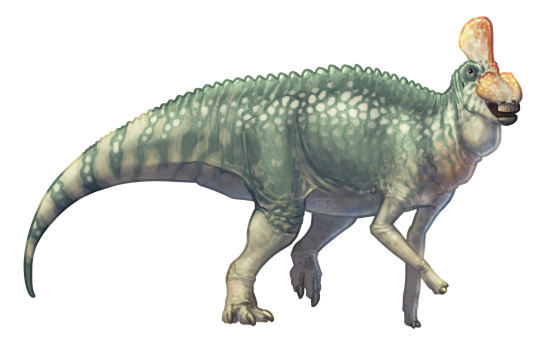

Factfiles:
Ajnabia odysseus

Artwork by @i-draws-dinosaurs, written by @zygodactylus
Name Meaning: Great Seafarer Stranger
Time: 68 to 66 million years ago (Maastrichtian stage of the Late Cretaceous)
Location: Upper member of the Couche III Formation, Ouled Abdoun Basin, north-central Morocco
Ajnabia is an extremely small (possibly the smallest) hadrosaur, specifically a European lambeosaurine. Finding one in Morocco was a legitimate surprise discovery, since northern Africa was fully separated from Europe by ocean at the time. Known from parts of the jaw, most of what we know about it is inferred from its probable close relatives, the North African-European Maastrichtian hadrosaurs - though the crests of these animals are not well known, it is presumable they for the group would have been hollow and shaped in different ways to produce different sounds based on species, including Ajnabia. As in other hadrosaurs, it would have been robust, with long robust and stiff tails, muscular hind limbs with three toed feet, and strong slender forelimbs ending in weird hoof-like structures. They also had rows and rows of densely packed teeth built for grinding through a variety of vegetation. It probably got from Eurasia to Africa via oceanic dispersal, possibly even swimming from one landmass to another. At less than four meters long, it would have been dwarfed by its newfound neighbors, large dinosaurs such as the abelisaurid Chenanisaurus, and a yet-unnamed titanosaur. There were also, of course, azhdarchids in the form of Phosphatodraco and pteranodontid Tethydraco, and three separate types of Nyctosaurids - Alcione, Simurghia, and Barbaridactylus (you may recognize this lineup from a certain paleo doc). On the ocean side of things, mosasaurs, elasmosaurs, sharks, fish, and other marine life filled the seas to the brim, making it even more of a wonder that Ajnabia got over to Morocco safely!
Tlatolophus galorum

Artwork by Joaquin Eng Ponce, written by @zygodactylus
Artwork by Joaquin Eng Ponce, written by Meig
Name Meaning: Gazra and López’s Word Crest
Time: 73 million years ago (Campanian stage of the Late Cretaceous)
Location: Cerro del Pueblo Formation, Coahuila, Mexico
Tlatolophus was a Lambeosaur - so another crested hadrosaur - from Mexico, a place that we don’t talk about the fossils of nearly enough! The most complete Lambeosaur known from Mexico, the skull and large portions of the skeleton are known, including the tail. At about 8 meters long, Tlatolophus had a tall skull and thick tail, and the usual hooved front feet of hadrosaurs. Its crest was long, low, and angled backwards, much like the glyph for “word” in Aztec writings - hence its name! Given the unique shape, it probably made a unique sound, different from other hadrosaurs. Interestingly, it actually seems to have been closely related to Parasaurolophus and its relatives, making it another member of the Parasaurolophini group! As a hadrosaur, it would have been a social animal, with behaviors such as communal nature and communication. The Cerro del Pueblo formation was a coastal ecosystem, filled with a variety of unnamed dinosaurs, but also Coahuilaceratops, Kritosaurus, Latirhinus, Velafrons, Paraxenisaurus (the first potential Deinocheirid from North America), as well as pterosaurs, turtles, fish, and multituberculate mammals.
DMM Round One Masterpost
#dmm#dinosaur march madness#dmm round one#dmm rising stars#palaeoblr#dinosaurs#paleontology#bracket#march madness#polls#ajnabia#tlatolophus
106 notes
·
View notes
Audio
(AJNABIA❤️❗️✌🏾✝️)
0 notes
Text
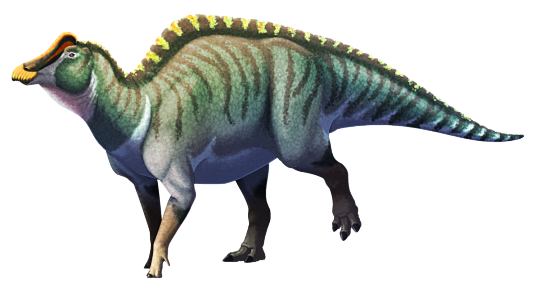
For a long time there were no hadrosaurid fossils known from Africa.
This seemed to mainly be due to the limits of the geography of their time. Hadrosaurs evolved and flourished during the late Cretaceous, when Africa was isolated from all the other continents, and they didn't seem to have ever found their way across the oceanic barriers.
…Until in 2021 a small hadrosaur was discovered in Morocco, a close relative of several European species, showing that some of these dinosaurs did reach northwest Africa just before the end of the Cretaceous - and with no land bridges or nearby island chains to hop along, they must have arrived from Europe via swimming, floating, or rafting directly across several hundred kilometers of deep water.
And now another hadrosaur has just been described from the same time and place.
Minqaria bata lived in Morocco at the very end of the Cretaceous, about 67 million years ago. Only known from a partial skull, its full appearance and body size is unknown, but it probably measured around 3.5m long (~11'6") – slightly larger than its previously discovered relative, but still very small for a hadrosaur. It might represent a case of insular dwarfism, since at the time Morocco may have been an island isolated from the rest of northwest Africa.
Along with its close relative Ajnabia, and at least one other currently-unnamed larger hadrosaur species, Minqaria seems to be part of a rapid diversification of hadrosaurs following their arrival in Morocco, adapting into new ecological niches in their new habitat where the only other herbivorous dinosaur competition was titanosaurian sauropods, and the only large predators were abelisaurs.
If the K-Pg mass extinction hadn't happened just a million years later, who knows what sort of weird African hadrosaurs we could have ended up with?
———
NixIllustration.com | Tumblr | Patreon
#science illustration#paleontology#paleoart#palaeoblr#minqaria#hadrosaur#hadrosauridae#ornithopod#ornithischia#dinosaur#art#insular dwarfism#african hadrosaurs!
435 notes
·
View notes
Text
Minqaria bata Longrich et al., 2024 (new genus and species)

(Type specimen of Minqaria bata [scale bar = 5 cm], from Longrich et al., 2024)
Meaning of name: Minqaria = beak [in Arabic]; bata = duck [in Arabic]
Age: Late Cretaceous (Maastrichtian)
Where found: Sidi Chennane, Béni Mellal-Khénifra, Morocco
How much is known: Partial skull of one individual.
Notes: Minqaria was a hadrosaurid (duck-billed dinosaur). It was small for a member of this group, estimated as having been about 3.5 m in total body length and weighing around 250 kg. Another hadrosaurid of similar size, Ajnabia, lived alongside it, suggesting that a range of small hadrosaurids were present in North Africa near the end of the Cretaceous.
Reference: Longrich, N.R., X. Pereda-Suberbiola, N. Bardet, and N.-E. Jalil. 2024. A new small duckbilled dinosaur (Hadrosauridae: Lambeosaurinae) from Morocco and dinosaur diversity in the late Maastrichtian of North Africa. Scientific Reports 14: 3665. doi: 10.1038/s41598-024-53447-9
109 notes
·
View notes
Note
you like dinos? name every dino
Aardonyx Abdarainurus Abelisaurus Abrictosaurus Abrosaurus Abydosaurus Acantholipan Acanthopholis Achelousaurus Acheroraptor Achillesaurus Achillobator Acristavus Acrocanthosaurus Acrotholus Adamantisaurus Adasaurus Adelolophus Adeopapposaurus Adratiklit Adynomosaurus Aegyptosaurus Aeolosaurus Aeolosaurus Aepyornithomimus Aerosteon Afromimus Afrovenator Agathaumas Agilisaurus Agrosaurus Agujaceratops Agujaceratops Agustinia Ahshislepelta Ajkaceratops Ajnabia Akainacephalus Alamitornis Alaskacephale Albalophosaurus Albertaceratops Albertadromeus Albertavenator Albertonykus Albertosaurus Albinykus Alcmonavis Alcovasaurus Alectrosaurus Aletopelta Algoasaurus Alioramus Alioramus Allosaurus Allosaurus Allosaurus Almas Alnashetri Altirhinus Altispinax Alvarezsaurus Alxasaurus Amanzia Amargasaurus Amargatitanis Amazonsaurus Ambiortus Ambopteryx Ampelosaurus Amphicoelias Amtocephale Amurosaurus Amygdalodon Anabisetia Analong Anasazisaurus Anchiceratops Anchiornis Anchisaurus Andesaurus Angolatitan Angulomastacator Anhuilong Aniksosaurus Animantarx Ankylosaurus Anodontosaurus Anomalipes Anoplosaurus Anserimimus Antarcticavis Antarctopelta Antarctosaurus Antarctosaurus Antarctosaurus Antarctosaurus Antetonitrus Antrodemus Anzu Aoniraptor Aorun Apatoraptor Apatornis Apatosaurus Apatosaurus Appalachiosaurus Apsaravis Aquilarhinus Aquilops Arackar Aragosaurus Aralosaurus Aratasaurus Archaeoceratops Archaeoceratops Archaeodontosaurus Archaeopteryx Archaeopteryx Archaeorhynchus Archaeornithoides Archaeornithomimus Archaeornithomimus Archaeornithura Arcovenator Arcusaurus Arenysaurus Argentinosaurus Argyrosaurus Aristosuchus Arkansaurus Arkharavia Arrhinoceratops Arrudatitan Asfaltovenator Asiaceratops Asiaceratops Asiahesperornis Asiatosaurus Asiatosaurus Astrophocaudia Asylosaurus Atacamatitan Atlantosaurus Atlantosaurus Atlasaurus Atlascopcosaurus Atrociraptor Atsinganosaurus Aublysodon Aucasaurus Augustynolophus Auroraceratops Aurornis Australodocus Australotitan Australovenator Austrocheirus Austroposeidon Austroraptor Austrosaurus Avaceratops Aviatyrannis Avimimus Avimimus Avisaurus
Baalsaurus Bactrosaurus Bactrosaurus Bagaceratops Bagaraatan Bagualia Bagualosaurus Bahariasaurus Bainoceratops Bainoceratops Bajadasaurus Balaur Bambiraptor Banji Bannykus Baotianmansaurus Baptornis Barapasaurus Barilium Barosaurus Barrosasaurus Barsboldia Baryonyx Bashanosaurus Batyrosaurus Batyrosaurus Baurutitan Bauxitornis Bayannurosaurus Beg Beibeilong Beiguornis Beipiaognathus Beipiaosaurus Beishanlong Bellusaurus Berberosaurus Berthasaura Bicentenaria Bienosaurus Bissektipelta Bistahieversor Blasisaurus Blikanasaurus Bohaiornis Bolong Boluochia Bonapartenykus Bonapartenykus Bonapartesaurus Bonatitan Bonitasaura Borealopelta Borealosaurus Boreonykus Borogovia Bothriospondylus Brachiosaurus Brachyceratops Brachylophosaurus Brachytrachelopan Bradycneme Brasilotitan Bravasaurus Bravoceratops Breviceratops Brighstoneus Brodavis Brodavis Brodavis Brodavis Brohisaurus Brontomerus Brontosaurus Buitreraptor Burianosaurus Buriolestes Byronosaurus
Caenagnathasia Caenagnathus Caihong Calamosaurus Callovosaurus Camarasaurus Camarasaurus Camarasaurus Camarasaurus Camarillasaurus Camelotia Camposaurus Camptodontornis Camptosaurus Campylodoniscus Canadaga Canardia Carcharodontosaurus Carcharodontosaurus Cardiodon Carnotaurus Caseosaurus Cathartesaura Caudipteryx Caudipteryx Cedarosaurus Cedarpelta Cedrorestes Centrosaurus Ceramornis Cerasinops Ceratonykus Ceratops Ceratosaurus Ceratosaurus Ceratosaurus Ceratosuchops Cerebavis Cetiosauriscus Cetiosaurus Changchengornis Changchunsaurus Changmiania Changyuraptor Changzuiornis Chaoyangia Chaoyangsaurus Charonosaurus Chasmosaurus Chasmosaurus Chasmosaurus Chebsaurus Chenanisaurus Chialingosaurus Chiappeavis Chiayusaurus Chiayusaurus Chilantaisaurus Chilesaurus Chindesaurus Chingkankousaurus Chinshakiangosaurus Chirostenotes Choconsaurus Chondrosteosaurus Chongmingia Choyrodon Chromogisaurus Chuandongocoelurus Chuanjiesaurus Chuanqilong Chubutisaurus Chungkingosaurus Chupkaornis Chuxiongosaurus Cimolopteryx Cimolopteryx Citipati Citipes Claosaurus Coahuilaceratops Coelophysis Coelurus Colepiocephale Coloradisaurus Comahuesaurus Compsognathus Compsosuchus Concavenator Conchoraptor Concornis Condorraptor Confuciusornis Confuciusornis Confuciusornis Confuciusornis Convolosaurus Coronosaurus Corythoraptor Corythosaurus Corythosaurus Craspedodon Craterosaurus Cretaaviculus Crichtonpelta Crichtonsaurus Cristatusaurus Crittendenceratops Cruxicheiros Cryolophosaurus Cumnoria
Dacentrurus Daemonosaurus Dakotadon Dakotaraptor Dalianraptor Daliansaurus Dandakosaurus Daspletosaurus Daspletosaurus Datanglong Datonglong Datousaurus Daurlong Daxiatitan Deinocheirus Deinodon Deinonychus Deltadromeus Demandasaurus Denversaurus Diabloceratops Diamantinasaurus Dicraeosaurus Dilong Dilophosaurus Diluvicursor Dineobellator Dinheirosaurus Diplodocus Diplodocus Diplodocus Dongbeititan Dongyangopelta Dongyangosaurus Draconyx Dracoraptor Dracovenator Dreadnoughtus Dromaeosauroides Dromaeosaurus Dromiceiomimus Drusilasaura Dryosaurus Dryptosaurus Dubreuillosaurus Duriatitan Duriavenator Dynamoterror Dyoplosaurus Dysalotosaurus Dysganus Dysganus Dysganus Dysganus Dyslocosaurus Dzharaonyx Dzharatitanis
Echinodon Edmontonia Edmontonia Edmontosaurus Edmontosaurus Efraasia Einiosaurus Ekrixinatosaurus Elaltitan Elaphrosaurus Elmisaurus Elopteryx Elrhazosaurus Emausaurus Enaliornis Enaliornis Enaliornis Enantiophoenix Enigmosaurus Eoabelisaurus Eocarcharia Eoconfuciusornis Eocursor Eodromaeus Eogranivora Eolambia Eomamenchisaurus Eoraptor Eosinopteryx Eotrachodon Eotriceratops Eotyrannus Eousdryosaurus Epachthosaurus Epanterias Epichirostenotes Epidexipteryx Equijubus Erectopus Erketu Erliansaurus Erlikosaurus Erythrovenator Eshanosaurus Eucamerotus Eucercosaurus Eucnemesaurus Eucnemesaurus Euhelopus Euoplocephalus Europasaurus Europatitan Europelta Euskelosaurus Eustreptospondylus Evgenavis Evgenavis
Falcarius Falcatakely Ferganasaurus Ferrisaurus Foraminacephale Fosterovenator Fostoria Fruitadens Fukuipteryx Fukuiraptor Fukuisaurus Fukuititan Fukuivenator Fulgurotherium Fumicollis Fushanosaurus Fusuisaurus Futalognkosaurus Fylax
Galeamopus Galeamopus Galleonosaurus Gallimimus Gallornis Galvesaurus Gannansaurus Gansus Gansus Ganzhousaurus Gargantuavis Gargoyleosaurus Garrigatitan Garudimimus Gasosaurus Gasparinisaura Gastonia Gastonia Geminiraptor Genusaurus Genyodectes Geranosaurus Gettyia Gideonmantellia Giganotosaurus Gigantoraptor Gigantspinosaurus Gilmoreosaurus Gilmoreosaurus Gilmoreosaurus Gilmoreosaurus Giraffatitan Glacialisaurus Glishades Glyptodontopelta Gnathovorax Gobihadros Gobioolithus Gobioolithus Gobipteryx Gobiraptor Gobisaurus Gobititan Gobivenator Gojirasaurus Gondwanatitan Gongpoquansaurus Gongxianosaurus Gorgosaurus Goyocephale Graciliceratops Graciliraptor Gravitholus Gryphoceratops Gryposaurus Gryposaurus Gryposaurus Gryposaurus Guaibasaurus Gualicho Guanlong Guemesia
Hadrosaurus Haestasaurus Hagryphus Halimornis Halszkaraptor Hamititan Hanssuesia Haplocanthosaurus Haplocanthosaurus Haplocheirus Harpymimus Haya Heptasteornis Herrerasaurus Hesperonychus Hesperornis Hesperornis Hesperornis Hesperornis Hesperornis Hesperornis Hesperornis Hesperornis Hesperornis Hesperornis Hesperornis Hesperornithoides Hesperosaurus Heterodontosaurus Hexing Hexinlusaurus Heyuannia Hippodraco Histriasaurus Hollanda Homalocephale Hongshanornis Hoplitosaurus Horshamosaurus Hortalotarsus Huabeisaurus Hualianceratops Huallasaurus Huanansaurus Huanghetitan Huangshanlong Huaxiagnathus Huayangosaurus Hudiesaurus Huehuecanauhtlus Huinculsaurus Hulsanpes Hungarosaurus Hylaeosaurus Hypacrosaurus Hypacrosaurus Hypselosaurus Hypselospinus Hypsilophodon
Iaceornis Iberospinus Ibirania Ichthyornis Ichthyovenator Ignavusaurus Iguanacolossus Iguanodon Iguanodon Iguanodon Ilokelesia Imperobator Incisivosaurus Indosaurus Indosuchus Ingentia Intiornis Invictarx Irisosaurus Irritator Isaberrysaura Isanosaurus Isasicursor Ischioceratops Isisaurus Issi Itapeuasaurus Itemirus Iuticosaurus Iyuku
Jainosaurus Jakapil Jaklapallisaurus Janenschia Jaxartosaurus Jeholornis Jeholornis Jeholornis Jeholosaurus Jeyawati Jianchangornis Jianchangosaurus Jiangjunosaurus Jiangshanosaurus Jiangxisaurus Jianianhualong Jibeinia Jinbeisaurus Jinfengopteryx Jingshanosaurus Jinguofortis Jintasaurus Jinyunpelta Jinzhousaurus Jiuquanornis Jiutaisaurus Jixiangornis Jobaria Judiceratops Judinornis Juratyrant Juravenator
Kaatedocus Kaijiangosaurus Kaijutitan Kakuru Kamuysaurus Kangnasaurus Kansaignathus Kaririavis Karongasaurus Katepensaurus Kayentavenator Kazaklambia Kelmayisaurus Kelumapusaura Kentrosaurus Kerberosaurus Khaan Khinganornis Kholumolumo Khulsanurus Kileskus Kinnareemimus Klamelisaurus Kol Kompsornis Kookne Koparion Koreaceratops Koreanosaurus Koshisaurus Kosmoceratops Kotasaurus Kritosaurus Kryptops Kulceratops Kulindadromeus Kunbarrasaurus Kundurosaurus Kuru Kurupi Kuszholia
Labocania Laevisuchus Laiyangosaurus Lajasvenator Lamarqueavis Lamarqueavis Lamarqueavis Lambeosaurus Lambeosaurus Lambeosaurus Lanzhousaurus Lapampasaurus Laplatasaurus Lapparentosaurus Laquintasaura Latenivenatrix Latirhinus Latirhinus Lavocatisaurus Leaellynasaura Ledumahadi Leinkupal Leonerasaurus Lepidus Leptoceratops Leptorhynchos Leshansaurus Lesothosaurus Lessemsaurus Levnesovia Lexovisaurus Leyesaurus Liaoceratops Liaoningosaurus Liaoningotitan Liaoningvenator Ligabueino Ligabuesaurus Liliensternus Limaysaurus Limenavis Limusaurus Lingwulong Lingyuanosaurus Linhenykus Linheraptor Linhevenator Lirainosaurus Liubangosaurus Llukalkan Lohuecotitan Longicrusavis Longipteryx Longirostravis Longusunguis Lophorhothon Lophostropheus Loricatosaurus Losillasaurus Lourinhasaurus Luanchuanraptor Lucianovenator Lufengosaurus Lufengosaurus Luoyanggia Lurdusaurus Lusotitan Lusovenator Lycorhinus Lythronax
Maaqwi Machairasaurus Machairoceratops Macrocollum Macrogryphosaurus Macrurosaurus Macrurosaurus Magnamanus Magnapaulia Magnosaurus Magyarosaurus Magyarosaurus Mahakala Mahuidacursor Maiasaura Maip Majungasaurus Malarguesaurus Malawisaurus Maleevus Mamenchisaurus Mamenchisaurus Mamenchisaurus Mamenchisaurus Mamenchisaurus Mamenchisaurus Manidens Mantellisaurus Mapusaurus Maraapunisaurus Marmarospondylus Marshosaurus Martharaptor Masiakasaurus Massospondylus Massospondylus Matheronodon Maxakalisaurus Mbiresaurus Medusaceratops Megalosaurus Megapnosaurus Megapnosaurus Megaraptor Mei Melanorosaurus Mendozasaurus Menefeeceratops Mengciusornis Menucocelsior Meraxes Mercuriceratops Meroktenos Metriacanthosaurus Microceratus Microceratus Micropachycephalosaurus Microraptor Microraptor Microraptor Microvenator Mierasaurus Minmi Minotaurasaurus Miragaia Mirarce Mirischia Mnyamawamtuka Moabosaurus Mochlodon Mochlodon Mongolostegus Monkonosaurus Monolophosaurus Mononykus Montanoceratops Morelladon Moros Morrosaurus Mosaiceratops Murusraptor Mussaurus Muttaburrasaurus Muyelensaurus Mymoorapelta Mystiornis
Naashoibitosaurus Nambalia Nankangia Nanningosaurus Nanosaurus Nanshiungosaurus Nanuqsaurus Nanyangosaurus Narambuenatitan Narindasaurus Nasutoceratops Natovenator Navajoceratops Nebulasaurus Nedcolbertia Nedoceratops Neimongosaurus Nemegtomaia Nemegtonykus Neogaeornis Neosodon Neovenator Neuquenornis Neuquenraptor Ngwevu Nhandumirim Niebla Nigersaurus Ningyuansaurus Ninjatitan Niobrarasaurus Nipponosaurus Noasaurus Nodocephalosaurus Nodosaurus Nomingia Nopcsaspondylus Normanniasaurus Notatesseraeraptor Nothronychus Notoceratops Notocolossus Notohypsilophodon Nqwebasaurus Nullotitan Nuthetes
Oceanotitan Ohmdenosaurus Ojoceratops Ojoraptorsaurus Oksoko Olorotitan Omeisaurus Omeisaurus Omeisaurus Omeisaurus Omeisaurus Omeisaurus Omeisaurus Omeisaurus Omnivoropteryx Ondogurvel Oohkotokia Oplosaurus Orkoraptor Ornatops Ornitholestes Ornithomimus Ornithomimus Ornithomimus Ornithopsis Orodromeus Orthomerus Oryctodromeus Osmakasaurus Ostafrikasaurus Ostromia Ouranosaurus Overoraptor Overosaurus Oviraptor Owenodon Oxalaia Ozraptor
Pachycephalosaurus Pachyrhinosaurus Pachyrhinosaurus Pachyrhinosaurus Padillasaurus Palaeopteryx Palintropus Paludititan Pampadromaeus Pamparaptor Panamericansaurus Pandoravenator Panguraptor Panoplosaurus Panphagia Pantydraco Papiliovenator Parabohaiornis Parahesperornis Parahesperornis Parahongshanornis Paralitherizinosaurus Paranthodon Parapengornis Pararhabdodon Parasaurolophus Parasaurolophus Parasaurolophus Paraxenisaurus Pareisactus Parksosaurus Paronychodon Paronychodon Parvicursor Pasquiaornis Pasquiaornis Patagonykus Patagonykus Patagopteryx Patagosaurus Patagotitan Pawpawsaurus Pectinodon Pedopenna Pegomastax Pelecanimimus Pellegrinisaurus Peloroplites Pelorosaurus Pendraig Penelopognathus Pengornis Pentaceratops Perijasaurus Petrobrasaurus Phaedrolosaurus Philovenator Phuwiangosaurus Phuwiangvenator Phyllodon Piatnitzkysaurus Pilmatueia Pinacosaurus Pinacosaurus Piscivoravis Pitekunsaurus Piveteausaurus Planicoxa Plateosaurus Plateosaurus Plateosaurus Platypelta Plesiohadros Pneumatoraptor Poekilopleuron Polacanthus Polarornis Polyodontosaurus Polyonax Potamornis Powellvenator Pradhania Prenocephale Prenoceratops Priconodon Proa Probactrosaurus Probrachylophosaurus Proceratosaurus Procompsognathus Proornis Propanoplosaurus Prosaurolophus Protarchaeopteryx Protoceratops Protoceratops Protognathosaurus Protohadros Psittacosaurus Psittacosaurus Psittacosaurus Psittacosaurus Psittacosaurus Psittacosaurus Psittacosaurus Psittacosaurus Psittacosaurus Psittacosaurus Psittacosaurus Psittacosaurus Pterospondylus Puertasaurus Pukyongosaurus Pulanesaura Punatitan Pycnonemosaurus Pyroraptor
Qantassaurus Qianzhousaurus Qiaowanlong Qijianglong Qinlingosaurus Qiupalong Qiupanykus Quetecsaurus Quilmesaurus
Rahiolisaurus Rahonavis Rajasaurus Rapator Rapaxavis Rapetosaurus Raptorex Ratchasimasaurus Rativates Rayososaurus Rebbachisaurus Regaliceratops Regnosaurus Rhabdodon Rhabdodon Rhadinosaurus Rhinorex Rhoetosaurus Rhomaleopakhus Riabininohadros Rinchenia Rinconsaurus Riojasaurus Riparovenator Rugocaudia Rugops Rukwatitan Ruyangosaurus
Sahaliyania Saichania Saltriovenator Sanjuansaurus Sanpasaurus Santanaraptor Sanxiasaurus Sapeornis Sarahsaurus Sarcosaurus Sarmientosaurus Saturnalia Saurolophus Saurolophus Sauroniops Sauropelta Saurophaganax Sauroplites Sauroposeidon Saurornithoides Saurornitholestes Saurornitholestes Savannasaurus Scansoriopteryx Scelidosaurus Schizooura Schleitheimia Scipionyx Sciurumimus Scolosaurus Scolosaurus Scutellosaurus Secernosaurus Sefapanosaurus Segisaurus Segnosaurus Seitaad Sektensaurus Serendipaceratops Serikornis Shamosaurus Shanag Shantungosaurus Shanweiniao Shanxia Shanyangosaurus Shaochilong Shengjingornis Shenqiornis Shenzhousaurus Shidaisaurus Shingopana Shishugounykus Shixinggia Shri Shuangbaisaurus Shuangmiaosaurus Shunosaurus Shuvuuia Siamodon Siamosaurus Siamotyrannus Siamraptor Siats Sibirotitan Sierraceratops Sigilmassasaurus Silvisaurus Similicaudipteryx Sinocalliopteryx Sinocephale Sinoceratops Sinornithoides Sinornithomimus Sinornithosaurus Sinornithosaurus Sinosauropteryx Sinosaurus Sinosaurus Sinotyrannus Sinovenator Sinraptor Sinraptor Sinusonasus Sirindhorna Skorpiovenator Smitanosaurus Songlingornis Sonidosaurus Sonorasaurus Soriatitan Soroavisaurus Spectrovenator Sphaerotholus Sphaerotholus Sphaerotholus Spiclypeus Spinophorosaurus Spinops Spinosaurus Spinostropheus Staurikosaurus Stegoceras Stegoceras Stegopelta Stegosaurus Stegosaurus Stegosaurus Stegouros Stellasaurus Stenonychosaurus Stenopelix Stokesosaurus Streptospondylus Struthiomimus Struthiosaurus Struthiosaurus Struthiosaurus Styracosaurus Styracosaurus Suchomimus Suchosaurus Suchosaurus Sulcavis Supersaurus Suskityrannus Suuwassea Suzhousaurus Syngonosaurus Szechuanosaurus
Tachiraptor Talarurus Talenkauen Talos Tamarro Tambatitanis Tangvayosaurus Tanius Tanius Tanycolagreus Taohelong Tapuiasaurus Tarbosaurus Tarchia Tarchia Tarchia Tastavinsaurus Tatankacephalus Tataouinea Tatisaurus Taurovenator Tawa Tazoudasaurus Tehuelchesaurus Telmatosaurus Tendaguria Tengrisaurus Tenontosaurus Tenontosaurus Teratophoneus Terminocavus Tethyshadros Texacephale Texasetes Thanatotheristes Thanos Thecocoelurus Thecodontosaurus Theiophytalia Therizinosaurus Thescelosaurus Tianyulong Tianyuornis Tianyuraptor Tianzhenosaurus Tienshanosaurus Timimus Timurlengia Tingmiatornis Titanoceratops Titanosaurus Titanosaurus Tlatolophus Tochisaurus Tonganosaurus Tongtianlong Tornieria Torosaurus Torosaurus Torvosaurus Torvosaurus Torvosaurus Tototlmimus Tralkasaurus Transylvanosaurus Tratayenia Traukutitan Triceratops Triceratops Trierarchuncus Trigonosaurus Trinisaura Triunfosaurus Troodon Tsaagan Tsagantegia Tsintaosaurus Tuebingosaurus Tugulusaurus Tuojiangosaurus Turanoceratops Turiasaurus Tylocephale Tyrannosaurus Tyrannotitan
Uberabatitan Ubirajara Udanoceratops Ultrasaurus Ulughbegsaurus Unaysaurus Unenlagia Unenlagia Unescoceratops Unquillosaurus Urbacodon Utahceratops Utahraptor Uteodon
Vahiny Valdoraptor Valdosaurus Vallibonavenatrix Variraptor Vayuraptor Vectaerovenator Vectiraptor Vegavis Velafrons Velocipes Velociraptor Velociraptor Velocisaurus Venenosaurus Vescornis Vespersaurus Veterupristisaurus Viavenator Vitakridrinda Volgatitan Volkheimeria Vorona Vouivria Vulcanodon
Wakinosaurus Walgettosuchus Wamweracaudia Wannanosaurus Weewarrasaurus Wellnhoferia Wendiceratops Wiehenvenator Wintonotitan Wuerhosaurus Wuerhosaurus Wulagasaurus Wulatelong Wulong
Xenoceratops Xenoposeidon Xenotarsosaurus Xianshanosaurus Xiaosaurus Xiaotingia Xingtianosaurus Xingxiulong Xinjiangovenator Xinjiangtitan Xiongguanlong Xixianykus Xixiasaurus Xiyunykus Xuanhanosaurus Xuanhuaceratops Xunmenglong Xuwulong
Yamaceratops Yamatosaurus Yandangornis Yangavis Yangchuanosaurus Yangchuanosaurus Yanornis Yanornis Yaverlandia Yehuecauhceratops Yi Yimenosaurus Yingshanosaurus Yinlong Yixianornis Yixianosaurus Yizhousaurus Yongjinglong Ypupiara Yuanchuavis Yuanmousaurus Yueosaurus Yulong Yunganglong Yunmenglong Yunnanosaurus Yunnanosaurus Yunnanosaurus Yunyangosaurus Yurgovuchia Yutyrannus Yuxisaurus
Zalmoxes Zalmoxes Zanabazar Zapalasaurus Zaraapelta Zby Zephyrosaurus Zhanghenglong Zhenyuanlong Zhongjianornis Zhongjianosaurus Zhongornis Zhongyuansaurus Zhouornis Zhuchengceratops Zhuchengtyrannus Ziapelta Zigongosaurus Zizhongosaurus Zuniceratops Zuolong Zuoyunlong Zupaysaurus Zuul
455 notes
·
View notes
Text
What if the dinosaurs hadn't gone extinct? Why our world might look very different
What if the dinosaurs hadn’t gone extinct? Why our world might look very different
Ajnabia odysseus lived 66 million years ago, making it one of the last dinosaurs on Earth Raul Martin
Sixty-six million years ago, an asteroid hit the Earth with the force of 10 billion atomic bombs and changed the course of evolution. The skies darkened and plants stopped photosynthesising. The plants died, then the animals that fed on them. The food chain collapsed. Over 90% of all species…

View On WordPress
0 notes
Photo

The tiny hadrosaur ajnabia finds itself in a sticky situation stalked by a chenanisaurus, ajnabia is from the late cretaceous of morocco and was described back in october.
#art#my art#digital art#paleoart#dinosaur#theropod#ornithopod#abelisaur#hadrosaur#cretaceous#prehistory
356 notes
·
View notes
Link
Fossils of a duckbill dinosaur have been discovered in Africa, leading experts to believe the species once traveled hundreds of kilometers across oceans to reach the continent.
The new dinosaur, Ajnabia odysseus, a member of the plant-eating duckbill dinosaur family, was discovered in rocks in a mine in Morocco, dating back some 66 million years to the end of the Cretaceous period. Though some duckbill dinosaurs could reach up to 15 meters (49 feet) long, experts say that Ajnabia was comparatively tiny, measuring the size of a pony at three meters (10 feet).
Experts were puzzled at how the dinosaur ended up in Africa, which was an island continent and completely isolated by deep sea during the Late Cretaceous...
51 notes
·
View notes
Text
The Top Ten Dinosaur Discoveries of 2020
https://sciencespies.com/nature/the-top-ten-dinosaur-discoveries-of-2020/
The Top Ten Dinosaur Discoveries of 2020

There’s never been a better time to be a dinosaur fan. Even in a year where fossil explorations have been curtailed because of the COVID-19 pandemic, paleontologists have dug deep to describe dozens of new species and unlock new secrets about our favorite prehistoric creatures. The discoveries continue even now, with the fluffy “maned” dinosaur Ubirajara named just last weekend. As we anticipate what the fossil record might reveal in 2021, here’s a look back at ten dinosaur discoveries that surprised and enthralled dinosaur enthusiasts this year.
Tiny Fuzzball Shows How Dinosaurs Started Small

Life restoration of Kongonaphon kely, a newly described reptile near the ancestry of dinosaurs and pterosaurs
(Illustration by Alex Boersma)
Some of the key traits that allowed dinosaurs to be such an evolutionary success story—from fuzzy feathers to warm-running metabolisms—may have first evolved in their tiny ancestors. This year experts reported the discovery of a tiny reptile from the Triassic of Madagascar they named Kongonaphon. While not a dinosaur itself, this animal was close to the ancestors of both dinosaurs and related flying reptiles called pterosaurs. This small, insect-eating reptile likely moved nimbly to catch lunch and may have sported a coat of fuzz to help regulate its body temperature. This hints that some key dinosaur traits, such as warm-bloodedness and insulating body coverings, evolved early in their history and were elaborated upon as dinosaurs eventually diversified into all sorts of shapes and sizes.
Winner By a Tail

Spinosaurus used its tail to swim
(Gustavo Monroy-Becerril CC BY-SA 4.0 )
Paleontologists have long suspected that the giant carnivore Spinosaurus spent much of its time around the water. Fossils reported in 2015 went a step further—flat feet and dense bones indicated that Spinosaurus spent a great deal of time in the water and is the first known semi-aquatic dinosaur. This year, a tail added another clue. The appendage, found at the same quarry as the 2015 skeleton, is long and deep. The tail is more like a paddle than what’s seen in other carnivorous dinosaurs and would have been suited to swishy, side-to-side motions that propelled Spinosaurus through the water. The fact that the tail goes with the other fossils found at the site also confirm that they all go to one individual, underscoring the fact that Spinosaurus had strange body proportions unlike any other dinosaur yet discovered.
Dinosaurs Suffered From Cancer, Too

A Centrosaurus skeleton in the mass dearth assemblage at the Royal Tyrrell Museum
(Riley Black)
Dinosaurs are often celebrated for being big, fierce and tough. The truth, however, is that they suffered from many of the same injuries and maladies that humans do. A study published this year in The Lancet reported on the first well-documented case of malignant bone cancer in a non-avian dinosaur. The animal, a horned dinosaur known to experts as Centrosaurus, probably coped with declining health before its eventual death in a coastal flood that caught its herd off-guard.
Dinosaurs Weren’t in Decline When the Asteroid Hit

A Tyrannosaurus rex holotype at the Carnegie Museum of Natural History
(ScottRobertAnselmo CC BY-SA 3.0)
If dinosaurs “ruled the Earth” for millions of years, why were they hit so hard by the mass extinction of 66 million years ago? Paleontologists have been puzzling over this question for decades, and, some have suggested, dinosaurs might have already been dying back by time the asteroid struck. But an increasing amount of evidence contracts that view, including a study published this year in Royal Society Open Science. The researchers looked at different evolutionary trees for what dinosaurs were around during the end of the Cretaceous to track whether dinosaurs were dying out, thriving or staying the same. After sifting through the data, the paleontologists didn’t find any sign that dinosaurs were declining before the asteroid strike. In fact, dinosaurs seemed perfectly capable of evolving new species. If the asteroid had missed, the Age of Dinosaurs would have continued for a very long time.
Taking a Long Swim
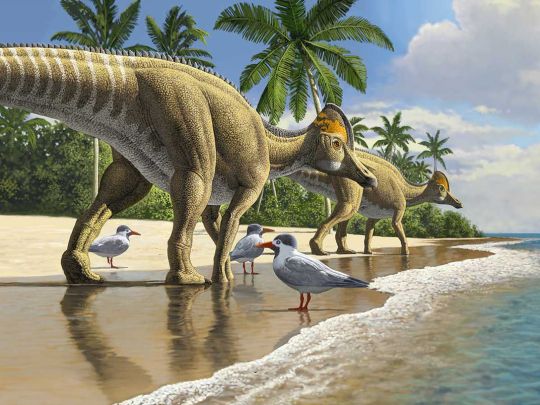
Researchers found the remains of a duckbilled dinosaur in Morocco.
(Raul Martin)
Sometimes dinosaurs show up where we don’t expect them. While paleontologists have found numerous fossils of duckbilled dinosaurs at spots around the world—from North America to Antarctica—no one had ever found one in Africa. That changed this year. In a Cretaceous Research study, paleontologists described a new species of hadrosaur found in Morocco. Named Ajnabia, the dinosaur lived at the end of the Cretaceous during a time when Africa was separated from other continents by deep water channels. Swimming would have been the only way for the dinosaur to reach prehistoric Africa from Europe or Asia, reinforcing the idea that exceptional events can help species move between distant continents.
Baby Titans Had Tiny Horns

A titanosaur embryo was discovered perfectly preserved inside its egg.
(University of Manchester)
Baby dinosaurs are exceptionally rare. We know far more about the adults of most species than how they started life. And when we do find those babies, they often hold surprises. An embryo of a long-necked dinosaur called a titanosaur reported in Current Biology drew attention this year for a strange, rhino-like horn jutting from its face. No such structure has been found in adult titanosaurs, and so it seems the horn is a kind of a temporary “egg tooth” that the dinosaur would have used to crack out of its shell.
Were Dinosaur Eggs Soft?

Protoceratops laid leathery eggs.
(AntoninJury CC BY-SA 4.0)
Think of a dinosaur egg and you’re likely to envision something out of Jurassic Park—a hard-shelled capsule the baby dinosaur has to kick or push its way out of. But research published this year in Nature proposes that many dinosaurs laid soft-shelled eggs. Under close examination, the eggs of the dinosaurs Protoceratops and Mussaurus turned out to be more like the leathery eggs of turtles than the thick, hard-shelled eggs known from other dinosaurs. This may indicate that dinosaur eggs started off soft and only later evolved to be hard-shelled in some groups. The findings may often indicate why eggs have been so hard to find for many dinosaur species, as softer eggs would decay more readily than hard-shelled ones.
Enter the Wonderchicken
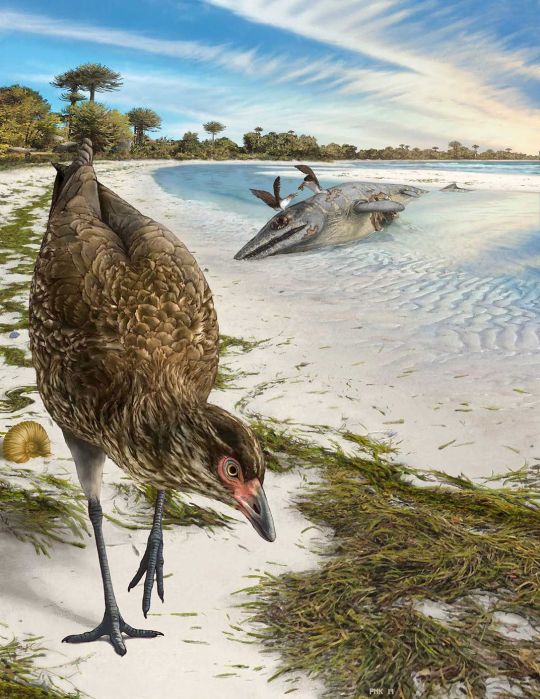
Artist’s reconstruction of the world’s oldest modern bird, Asteriornis maastrichtensis, in its original environment
(Phillip Krzeminski)
Not all this year’s big dinosaur discoveries had to do with non-avian dinosaurs. A fossil dubbed the “wonderchicken” in Nature has helped paleontologists understand how modern birds took off during the Age of Dinosaurs. While birds go back to about 150 million years ago, the wonderchicken—or Asteriornis—lived about 67 million years ago and is the oldest known representative of what biologists think of as modern birds. The fossil, which includes a skull, has some anatomical similarities to chickens and ducks. These findings indicate that modern birds started to evolve and proliferate prior to the mass extinction that wiped out the non-avian dinosaurs. If such beaked, seed-eating birds had not evolved, dinosaurs might have been entirely wiped out instead of leaving birds behind.
The Hunt for Dino DNA
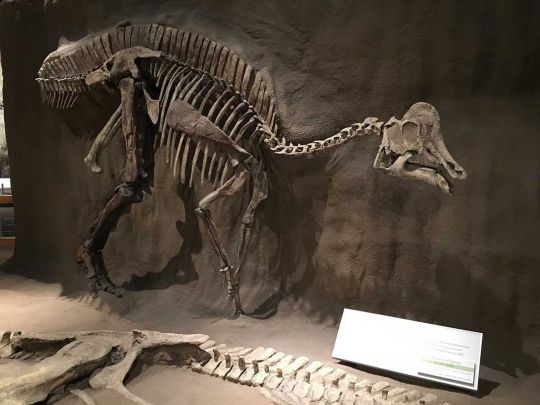
Hypacrosaurus was a 70 million-year-old hadrosaur.
(Riley Black)
Will DNA from the likes of Tyrannosaurus ever be found? The consensus has been “No,” as DNA decays too fast after death to survive millions and millions of years. But in a study published in National Science Review this year, researchers have proposed that they’ve found chemical signatures consistent with DNA in the bones of a 70 million-year-old hadrosaur called Hypacrosaurus. The results have yet to be expanded upon or verified, but the idea that even degraded DNA from non-avian dinosaurs might survive is tantalizing for all such a discovery might teach us about prehistoric life.
Polar Dinosaurs Remained Year Round

A fossil jawbone found in Alaska offers evidence that some dinosaurs stayed in polar habitats year-round.
(Andrey Atuchin)
Ever since paleontologists discovered dinosaur bones within the ancient Arctic Circle, experts have debated whether the polar dinosaurs stayed in their cool habitats year-round or migrated with the seasons. A tiny jaw from a young dinosaur now answers that question. Described in PLOS ONE, the fossil belonged to a young raptor-like dinosaur that lived in an ancient Alaskan habitat marked by harsh seasonal shifts and long, dark winters. That dinosaurs were nesting and hatching babies in these habitats indicates that they were capable of surviving the harsh winters, even when it snowed.
#Nature
5 notes
·
View notes
Note
Hello again! Ok my question for you today is what your favorite color is? Also I would love to hear what your favorite dinosaur is and why you think it’s the best:) ~Secret Santa 🎅🏻🎅🏻🎅🏻
Oooooo hello! My favorite color is purple! And my favorite dinosaur is the Ajnabia odysseus! I think it is the best because what scientists think it looks like is so funky-

✨Himb✨
What’s your favorite Dino?
3 notes
·
View notes
Text
February 2, 1922: the moment before Ulysses arrives
February 2, 1922: the moment before Ulysses arrives
http://www.sci-news.com/paleontology/ajnabia-odysseus-09023.html
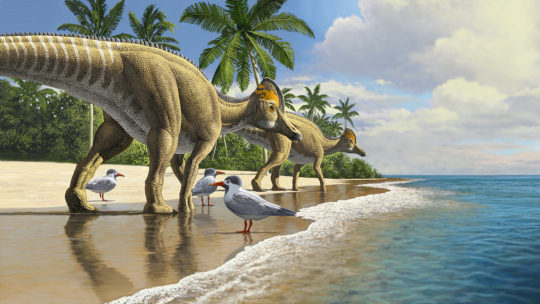
View On WordPress
1 note
·
View note
Text
Primera investigación en sugerir que los dinosaurios cruzaron el océano
Primera investigación en sugerir que los dinosaurios cruzaron el océano

[ad_1]
El estudio, publicado en Cretaceous Research, informa sobre el nuevo dinosaurio, Ajnabia odysseus, de rocas en Marruecos que datan de finales del Cretácico, hace 66 millones de años. Ajnabia era miembro de los dinosaurios pico de pato, diversos dinosaurios herbívoros que crecían hasta 15 metros de largo. Pero el nuevo dinosaurio era pequeño en comparación con sus parientes: con solo 3…
View On WordPress
0 notes
Text
Il primo fossile di dinosauro dal becco d’anatra Africano ci dà un’idea di come i dinosauri attraversavano gli oceani
Il primo fossile di dinosauro dal becco d’anatra Africano ci dà un’idea di come i dinosauri attraversavano gli oceani
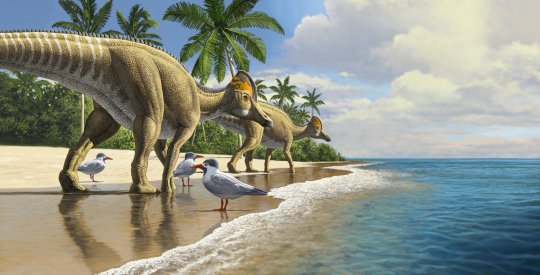
I dinosauri dal becco d’anatra si sono evoluti in Nord America, diffondendosi in Sud America, Asia, Europa e infine in Africa.
I primi fossili di un dinosauro a becco d’anatra sono stati scoperti in Africa, suggerendo che i dinosauri hanno attraversato centinaia di chilometri di mare aperto per arrivarci.
Lo studio, pubblicato su Cretaceous Research, parla del nuovo dinosauro, Ajnabia…
View On WordPress
0 notes
